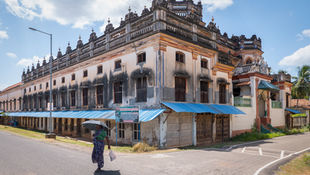In the 1870s, architectural photographer Albert Levy began capturing old buildings, thus giving rise to a new kind of photography called architectural photography. It is unlike any other kind of photography and poses its own challenges. The heritage photo captured can be of two kinds: exterior and interior. The blog will go into the depths of exterior photography and how documentation can be done on a historic building.
List of Contents
Capturing the Exterior of a Building
Exterior photographs taken in isolation do not tell a complete story. Buildings should be shown in relation to the surrounding landscape, where they are influenced by it or have an effect on it. They should form part of a complex, where at least one photograph should show the whole arrangement. Photographing different kinds of buildings requires different motives. Industrial or working buildings should be related to each other and to an element of motive power, like water. In a barren landscape, a figure can be included to indicate scale. Panoramic photography is another technique that can be utilised and involves elongated fields of view. Where sufficient distance is possible between camera and subject, panoramic views tell a more complete story of the relationship of a building with its surroundings.

Photographing an Exterior Elevation
Exterior photography of a building should be a depiction of it. The photograph should make the building easy to recognize and document. It should mainly include a straight-on, frontal view from all sides of the primary building, structure, or site. These photographs can be used to render the elevation.

Perspective views of each corner of the primary building, structure, or site should be taken. Photographs should be taken from at least two perspectives with respect to the smaller structures. This ensures the documentation of all contributing and non-contributing resources.


Views must be photographed such that they show the materials used in the construction of the building, structure, or site. Appropriate views that show how outbuildings or features relate to each other and to the landscape should also be taken so as to help document the building.
Exterior Choice of Viewpoint
The choice of viewpoint is an important consideration for every elevation. If a viewpoint is too elevated, it may show the layout, but the proportional relationships within the elevation are lost. Height gained by photographing from the first-floor window of any opposite building will reduce obstruction by foreground objects, e.g., railings, and prevent convergence of verticals. If the foreground object is of similar material to that of the elevation, attempts should be made to establish the baseline of the building by gaining height.


Use of Natural Light for Exterior
The use of natural light is the best way to enhance a photograph. Yet it needs to be utilised the right way to get the right depiction. Where an elevation has decoration or is constructed of different building materials, the front lighting is the best. Using frontal lighting and photographing a subject straight on is essential when a reconstruction has to be done. This allows all details to be seen without the confusion that might be caused by lengthy shadows. Acute-angled side lighting is appropriate when the camera is moving closer to obtain elevational detail.

Moving Closer to the Object
Photographing closer to the object can reveal details that could otherwise be neglected. It is to be done once the overall view is captured to get an idea of what to photograph up close. Once the general view of a building has been taken, a portion of it can be selected for a detailed recording. Detailed views can include, for instance, windows, doors, unusual features, construction style, or other notable elements.


Conclusion

Photographing a historic building for documentation purposes is different from that done for aesthetic purposes. Heritage documentation is not a dynamic process. It requires contemplation of the right scene or environment. Such a photograph can reveal important details about a structure. Thus, photographs must be taken from all angles. From the intricate, minute details to its form in relation to other buildings, the structure must be documented. The natural light falling on the building can be utilised by considering the time and position of the camera. The natural elements, such as bodies of water and trees, can be used as part of the frame of the photograph. The people in the frame can help understand the scale of the building with respect to the surroundings. Thus, architectural photography must also make use of the existing environment and elements on site.
Visit the links given below, to read some of our blogs:
















Comments